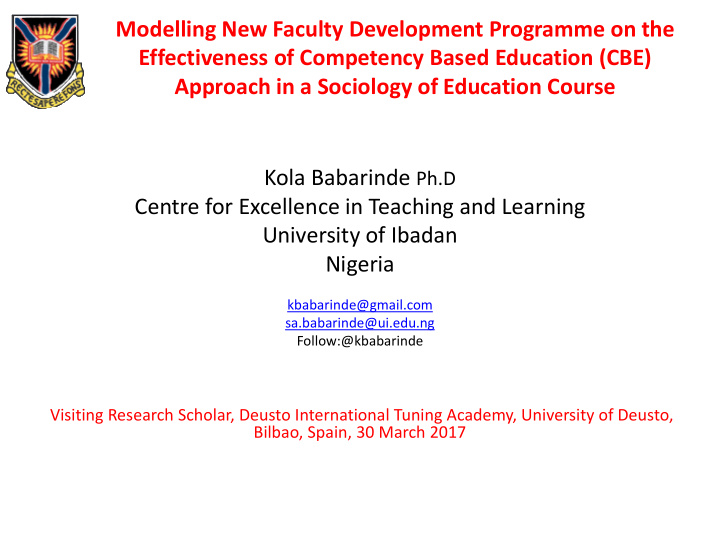



Modelling New Faculty Development Programme on the Effectiveness of Competency Based Education (CBE) Approach in a Sociology of Education Course Kola Babarinde Ph.D Centre for Excellence in Teaching and Learning University of Ibadan Nigeria kbabarinde@gmail.com sa.babarinde@ui.edu.ng Follow:@kbabarinde Visiting Research Scholar, Deusto International Tuning Academy, University of Deusto, Bilbao, Spain, 30 March 2017
Teaching and Learning Philosophy Eye on the World – Shirin Neshat (Detroit Institute of the Arts, MI, USA) May 2013
Dedication to a Departed Teacher Mentor and Friend Prof. kayode Ajayi 1951 – 17 March 2017.
Meeting the Presenter Nigeria Officially the Federal Republic of Nigeria, a federal constitutional republic comprising 36 states Capital: Abuja National anthem: Arise, O Compatriots Currency: Nigerian Naira Official language: English Language Population: 186,053,386 (July 2016 est.) World Bank Land Area: 923,766 sq.km. Government: Federal republic, Presidential system, Federation
Africa
Hausa-Fulani
Nigerian Tribes: Igbo
Yoruba
University of Ibadan, Nigeria
Sights of University of Ibadan, Nigeria
My Faculty Development Mandate
Centre for Excellence in Teaching and Learning To support faculty to improve their knowledge, skills and values of T&L and thus become more effective teachers promoting better learning
How Learning Takes Place Subject matter Learning Pedagogy
The Transmission Model Mainframe approach/Sage on the Stage Novices Expert Wilson, J.M. (2005) Creating New Learning Environments for Higher Education
Competency Based Education • Rejects blame model and adopts integrative model that takes T&L as complimentary. • It is more effective in achieving ILOs (Subject specific & Generic) hence, • Adopts several complimentary T&L strategies including evaluation. Biggs and Tang 2007
Integrative Model • Requires knowledge of how students learn; • Promotes high level activities resulting in deep learning; • Realises that students may use low level activities; • Notes that every teacher has some theory of teaching which affect how they teach; and • Affirms that good teaching supports appropriate learning activities and discourages inappropriate ones. Biggs and Tang 2007
Distributed Collaborative Model Client-server model/Guide on the Side Wilson, J.M. (2005) Creating New Learning Environments for Higher Education
Theoretical Background Plato’s Epistemology (Plato’s Cave, Analogy of the Cave) Illustrates human nature in its education and want of education (514a) The shadows are as close as the prisoners get to viewing reality. An attempt to explain the philosopher’s position in the society: to enlighten the “prisoners of appearances”.
Implications of Platonic Epistemology • How can we make the Faculty shift its gaze from the shadow to the light of educational and pedagogic research? • How can we persuade them to see the benefit of CBE in enhancing learning? and • Vary and deepen their teaching and learning practices?
Theoretical Background Cont’d Cognitive Dissonance The discomfort caused by holding conflicting ideas or cognitions simultaneously Implications Project employed as example of good practice to create cognitive dissonance and Openness to adoption
Conceptual Model Invitational Presentations Organised Workshops Integration Graduate CBE into Centre’s Assessment of Students Program Modelling Outcomes & Faculty Students of Sociology of Education Fig. 1: Illustration showing a conceptual model for CBE Adoption for students and Faculty.
Components of Competency Based Education T&L strategies Faculty Developer & Lecture Teaching Debate Presentation Assistants Excursion Reflection Guest Lecture Video Presentations Written Exams Assessment of Discussion Q&A T & L and Focus Group Discussion Outcomes Social Media Interaction Achievement 2 3 1 4 Types of ILOs Negotiated Learning Create Evaluate Analyse Apply Understand Remember Bloom’s Taxonomy Fig. 2: Illustration showing components of Competency Based Education used for this research.
Research Questions • To what extent did student assess the project as effective in achieving learning outcomes? • How can we get more practitioners to adopt positively rated aspects of this project? • How do we integrate this project into existing institutional programmes?
Methodology • Adopted a mixed method design and relied on both quantitative and qualitative data • Modelling of best practice approach • A graduate course in education consisting of 117 students and a faculty developer with teaching assistants for 14 weeks / one semester
Results and Discussions • Teaching effectiveness rated top 10% (70.8%); top 25% (24.5%). • Outcome achievement showed 78% as highest score and 40% lowest with average score being above 60 %. (57% scored 60% and above) • Teaching effectiveness was rated high (WA 4.40) • T&L strategies employed were rated as effective in achieving learning outcomes (WA between 1.85 and 2.94) • Prospects of CBE was also rated positive by Faculty.
Summary and Implications • Study affirmed effectiveness and prospects of CBE approach in achieving learning outcomes and for Faculty Development Programme. • Challenged us to proceed and formally integrate it into the Centre’s programme. • This is in consonance with earlier and related studies and the intervention of DITA through several projects across the world.
GRACIAS
Recommend
More recommend